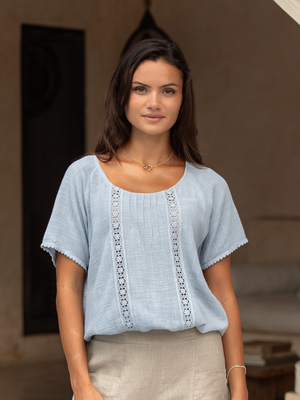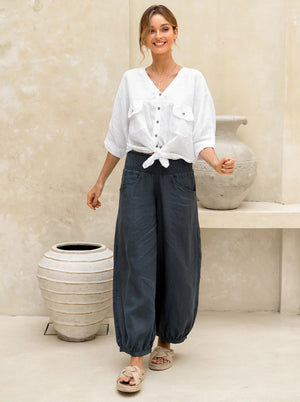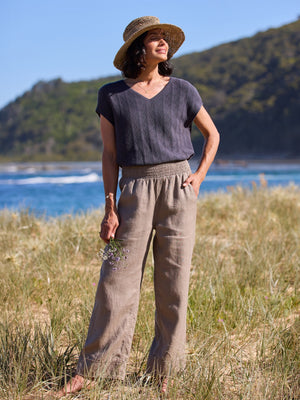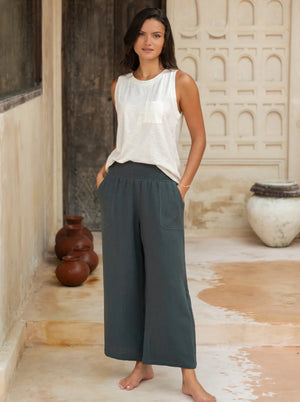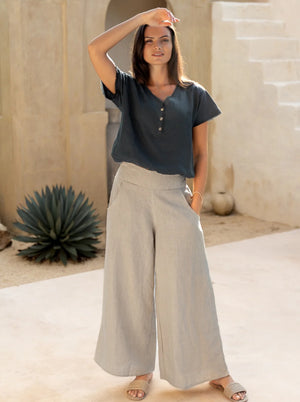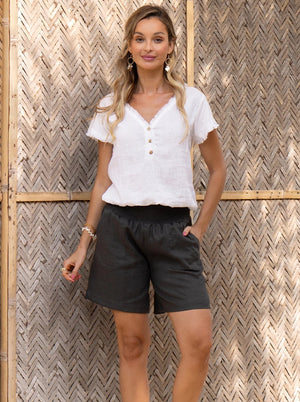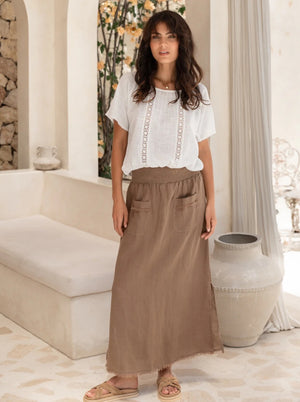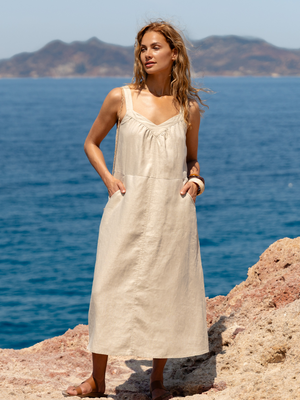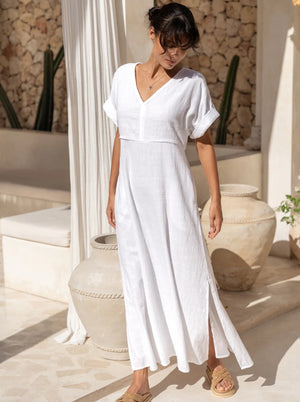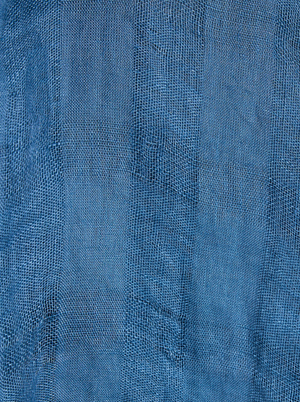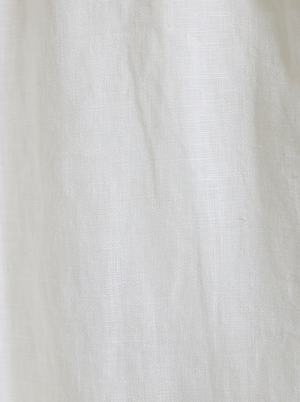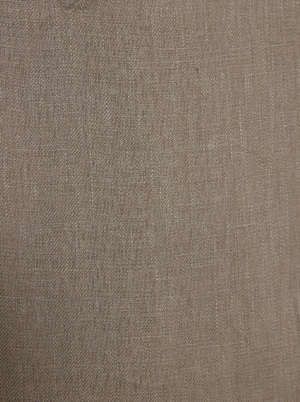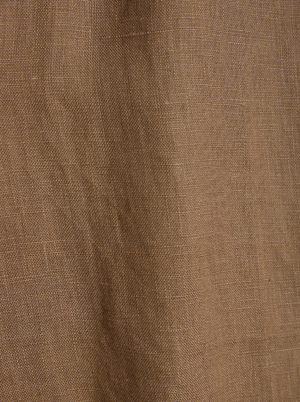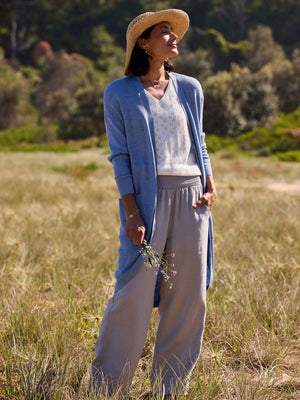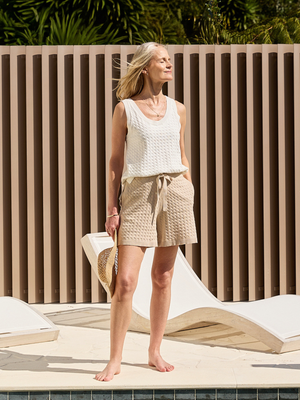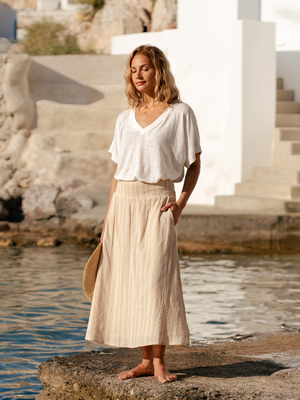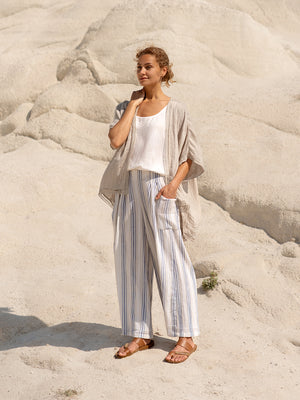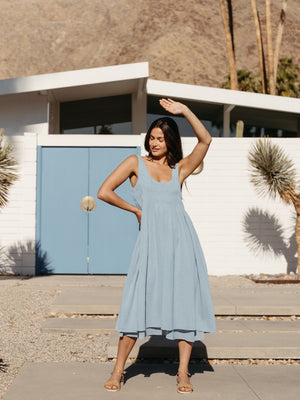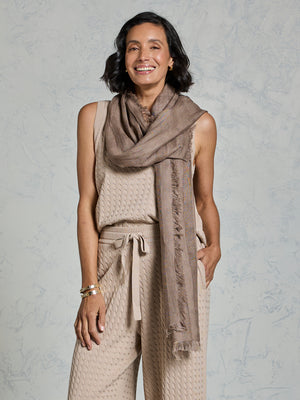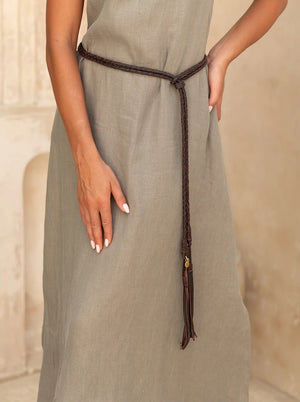Natural Fabrics: The Ultimate Guide to Eco-Friendly Textiles

Did you know that fashion brands make 70% of clothes, and much of the upholstery on sofas, curtains, and carpets is made from synthetic materials like polyester, nylon, and acrylic? When these items are produced, used, or washed, they release tiny plastic fibers into the air and water. As the Plastic Soup Foundation highlights, these microplastics can end up in our lungs, food, and water.
Research shows that chemicals like tributyl phosphate, dimethyl fumarate, and certain dyes used in synthetic fabrics can be harmful. They can cause skin reactions and asthma and even have links to cancer and reproductive issues.
A recent study in Nature Communications by Cotton Incorporated found that synthetic clothing contributes a staggering 7.4 million metric tons of plastic pollution yearly. According to Jesse Daystar, Ph.D., the vice president and chief sustainability officer at Cotton Incorporated, synthetic garments leak at least ten times more plastic than cotton clothing. He suggests using natural fibers, like cotton, can significantly reduce this plastic pollution.
Given these facts, we should ask ourselves whether we need synthetic fabrics like polyester and nylon in our wardrobes.
At Nomad the Label, we prioritize natural fabrics for our clothing. We believe natural fabrics are better for your skin, health, and planet. And we know that's what our customers are looking for.
This post will cover everything you need to know about natural fabrics. We'll explore what makes a fabric natural, how to identify it, its benefits and drawbacks, and tips for building a natural fabric capsule wardrobe. Plus, we'll share how to care for these fabrics so they last for years.
Let's dive in!
What are natural fibers?

Natural fibers are materials sourced directly from nature. They can be classified into two main categories: plant fibers and animal fibers.
Plant fibers consist of five basic types, as shown below:
Bas fibers: Jute, flax, hemp, ramie, kenaf
Leaf fibers: Banana, sisal, agave, pineapple
Seed fibers: Coir, cotton, kapok, coconut
Core fibers: Kenaf, hemp, jute, bamboo, napier grass
Grass and stem fibers: Wheat, corn, rice
Animal fibers are the second most widely used natural after plant fibers. They're generally made up of proteins and can be used as reinforcements in composites. Examples include sheep, goats, llamas, rabbits, and musk ox wool. Other animal fibers are silk, feathers, and hair.
Natural fibers are lightweight, biodegradable, renewable, and have excellent mechanical properties. Additionally, they provide good acoustic insulation, high specific stiffness, and are non-toxic.
What are the differences between synthetic and natural fabrics?
As said above, natural fabrics come from plants and animals. These fibers are generally biodegradable, breaking down over time and not harming the planet. They're also breathable and often more comfortable to wear.
A good example of natural fabrics is linen clothing and cotton clothing.
Conversely, synthetic fibers are artificially made from chemical substances. Common types include nylon, polyester, spandex, olefin, and acrylic. These materials are designed to be wrinkle-free, stain-resistant, and pest-resistant, making them convenient for everyday use. However, they rely heavily on fossil fuels like petroleum and natural gas for their production.

One significant concern with synthetic fibers is their environmental impact. During washing, synthetic fabrics shed tiny plastic particles called microplastics, which end up in our oceans and can harm marine life and human health. A 2017 report from the International Union for Conservation of Nature (IUCN) found that 35% of all microplastics in the ocean come from washing synthetic textiles like polyester.
Even recycled synthetic fibers still pose similar environmental risks as new synthetics. These fibers don't biodegrade quickly, taking hundreds of years to break down, contributing to long-term pollution.
Types of natural fabrics: sources, properties and uses
1. Linen fibers
Linen is one of the world's oldest and most beloved fabrics. Its rich history dates back to ancient Egypt, where it was used to wrap bodies for burial. Today, linen remains famous for its numerous benefits and eco-friendly properties.
Linen is made from flax plants. After about three months of growth, flax plants are harvested by pulling them from the root to maintain the entire length of the fibers. These fibers go through retting and soaking to loosen the outer bark and access the soft inner fibers. The natural color of linen is influenced by the sun, soil, and water during retting, making each batch unique.


Here's what makes linen an excellent choice for clothing:
Eco-friendly: Made from flax plants, linen is kind to the environment. It needs only rainwater to grow, uses minimal fertilizers and pesticides, and respects the land and wildlife.
Solid and durable: Linen is the most potent natural fiber, with 30% thicker and stronger fibers than cotton. This means your linen products will last longer and stay beautiful.
Unique and natural: The sun, soil, and water influence linen's natural color during processing, making each batch uniquely beautiful.
Breathable and comfortable: Linen is highly breathable and heat-conductive, keeping you cozy in the winter and cool in the summer.
Biodegradable: Linen is completely biodegradable, making it a sustainable choice that's good for the planet.
Our linens are OEKO-TEX® STANDARD 100, free from harmful chemicals, and meet the highest safety standards. Check out our signature wide-leg pants collection, featuring our best-selling Sadhu Pants, Del Mar, and more.
2. LENZING™ ECOVERO™
LENZING™ ECOVERO™ fibers are another natural fabric choice for those who value sustainability and quality. Made from wood, a natural and renewable resource, this type of natural fiber comes from responsibly managed forests and meets the strict standards of FSC® or PEFC certification.


Some standout benefits of LENZING™ ECOVERO™ fibers:
Eco-friendly production: These fibers use at least 50% less water and emit at least 50% less CO2 than generic viscose fibers. This means a significantly lower environmental impact.
Efficient dyeing process: Available in black, LENZING™ ECOVERO™ fibers are produced using a unique spin-dyeing process. Black color pigments are directly incorporated into the fibers, eliminating the need for additional dyeing steps.
Long-lasting color: Garments made with LENZING™ ECOVERO™ black fibers maintain their original appearance and color intensity for a more extended period, even with prolonged exposure to sunlight. The minimized risk of color loss or transfer ensures that your clothes look vibrant wash after wash.
Versatile blending: LENZING™ ECOVERO™ can be blended with other fibers such as cotton, polyester, wool, silk, linen, and acrylic. This provides various benefits, including enhanced breathability, a pleasant hand feel, and a beautiful sheen. The fibers bring a lovely softness and create an airy, flowy drape, opening up a wide range of design possibilities.
Our Freyja collection is made from 100% LENZING™ ECOVERO™. Each piece in this luxury collection is hand-dyed in small batches, making every garment unique. Explore the Freyja collection and experience the unmatched quality of this natural fabric.
3. Bamboo fibers
Bamboo is a member of the grass family Poaceae and can reach heights of up to 60 meters in just three months.
Bamboo thrives in tropical, subtropical, and temperate regions like Southeast Asia and South America. Its primary components include cellulose, hemicellulose, and lignin, which comprise over 90% of its total weight. The remaining elements are soluble polysaccharides, waxes, resins, tannins, proteins, and ashes.


Bamboo fabric offers several exceptional qualities:
Moisture absorption and permeability: Bamboo clothing absorbs moisture well and is highly breathable, keeping you comfortable without leaving perspiration marks. It's remarkable in summer and warm in winter.
Antibacterial and bacteriostatic: Bamboo fibers contain 'bamboo kun,' a unique antibacterial and bacteriostasis bio-agent. This substance remains in the finished fabric, significantly reducing bacterial growth and unpleasant odors.
Superior UV protection: Bamboo fabric offers excellent protection against ultraviolet rays, making it ideal for sun-exposed clothing.
Softness and drapability: The fabric is incredibly soft and smooth and drapes beautifully over the body.
Vibrant color and durability: Bamboo clothing features bright colors, a unique luster, good dyeing properties, and color fastness without toxic effects. It's also durable, scratch-resistant, and free of hair bulbs.
Antistatic properties: Bamboo fiber does not generate static electricity, making it comfortable to wear without clinging to the skin.
Bamboo fiber's ability to absorb moisture due to its micro-gaps ensures a comfortable fit next to the skin. Researchers have found that bacteria are reduced by almost 75% in bamboo fiber within 24 hours, compared to cotton and other wood pulp fibers. This antibacterial property makes bamboo fiber ideal for hygiene products like mattresses, sanitary towels, and table napkins. It's also famous for decorative items such as curtains, television covers, sofa slipcovers, and bathroom products like towels and bathrobes used in spas, hotels, and homes.
Check out our collection of bamboo clothing and accessories to experience bamboo's comfort, durability, and sustainability in your daily life.
4. Cotton fibers
Cotton is a natural cellulosic material and the second most common fiber in the world after polyester. You may be familiar with cotton products such as pajamas, towels, tea towels, T-shirts, and jeans.
Cotton fabric is prevalent in various applications, from domestic to commercial and industrial uses. Even with the introduction of synthetic fibers, cotton remains essential, particularly in the denim industry.


Cotton offers unique properties, making it an excellent choice for various products. Here are some of the key benefits:
Durability: Cotton can withstand rough treatment, including frequent washing.
Comfort: Soft and breathable, cotton is gentle on the skin and perfect for all-day wear.
Absorbency: Excellent for absorbing moisture, making it ideal for towels and activewear.
Versatility in dyeing: Cotton can take on a wide range of vibrant dyes, ensuring your clothes look great after washing.
Biodegradability: As a natural fiber, cotton is environmentally friendly and breaks down faster than synthetic fibers.
At Nomad the Label, cotton clothing is one of our signature collections.
5. Organic cotton fibers
Organic cotton is naturally grown without synthetic agricultural chemicals like fertilizers, pesticides, or transgenic technology. This cultivation method began in the 1980s to promote sustainable, ecological, and biodynamic agriculture. Organic cotton enhances biodiversity and biological cycles, benefiting human health and the environment.
Certified organic cotton is produced according to internationally recognized standards, including the EU regulation 834/2007, the US National Organic Program, the Indian National Programme for Organic Production, and the Japanese Agricultural Standard.


Organic cotton production involves a systemic approach to establishing a diverse and balanced farming ecosystem, including all types of crops and farm activities. Farms typically undergo a 2-year conversion period to transition from conventional to organic production. A key aspect of organic cotton farming is selecting varieties suited to local conditions regarding climate, soil, and resistance to pests and diseases.
Benefits of organic cotton:
Promotes biodiversity: Encourages diverse and balanced ecosystems.
Enhances biological cycles: Supports natural biological processes.
Beneficial to health and environment: Reduces exposure to harmful chemicals.
Sustainable farming practices: Fosters ecological and biodynamic agriculture.
Our beloved Daisy Organic Cotton Blouse is a perfect example of the beauty and quality of organic cotton. Consciously crafted from soft, textured cotton, this stylish blouse features a flattering, breezy fit and raglan sleeves for fluid movement. It's beautifully finished with a brass-beaded drawcord hem, offering styling versatility whether worn cinched or loose.
6. Ramie fibers
Like flax, ramie is also one of the oldest fiber crops, with a history spanning at least 6000 years. Its long-standing use includes being woven into mummy cloths in Egypt between 5000 and 3300 BC. Ramie has been cultivated in China for centuries, even before cotton was introduced in 1300 AD.
There are two types of ramie: "white ramie," also known as "Chinese grass," and "green ramie," or Rhea. Ramie is widely used in clothing, particularly summer apparel, household goods like bedspreads, and industrial applications such as high-quality packing cloth.


Benefits of ramie:
Strength and durability: Especially strong when wet.
High tenacity: Almost the highest among natural vegetable fibers.
Absorbency: Similar to flax and slightly better than cotton.
Lustrous appearance: Naturally white and shiny, almost like silk.
Crisp fabric: Stiff and rigid, providing a unique texture.
7. Hemp fibers
Hemp is a delicate, light-colored, shiny, and strong bast fiber obtained from the Cannabis sativa plant. It belongs to the mulberry family and is cultivated in Eastern Europe and Central Asia.
Hemp fibers are mechanically separated from the plant's woody core. Once cleaned and cut to the desired size, these fibers are primarily used in textiles, ropes, garden mulch, building materials, and animal bedding.


Hemp fabric is notably strong, up to three times stronger than cotton. It's also soft to the touch and maintains its shape well.
Here are some benefits of hemp fiber:
Durability: Hemp is stiff, lightweight, and durable, making it ideal for composite materials and wool insulation.
Breathability: Naturally breathable and highly water-absorbent.
Hypoallergenic: It's hypoallergenic and suitable for sensitive skin.
UV resistance: Hemp is resistant to UV light and anti-fungal.
Thermoregulation: Keeps you cool in summer and warm in winter.
Environmentally friendly: Requires little water, no pesticides, and minimal fertilization. Hemp is a carbon-negative crop, absorbing more CO2 than it produces.
Soil health: Its cultivation reduces pests, returns nutrients to the soil, and prevents soil erosion, making it excellent for crop rotation.
Efficient dyeing: High water absorbency means it takes dye well with minimal water waste.
8. Silk fibers
Silk has been cultivated for thousands of years, originating in ancient China. Today, Thailand, India, and Japan also have significant silk industries.
Silk fibers create soft, delicate, and smooth fabrics that drape beautifully and have a lustrous sheen. Silk provides comfort in warm weather and warmth in colder months, making it ideal for high-fashion clothing, nightwear, and lingerie.
One of the most popular uses of raw silk fabrics is in designer dresses for women. Traditional clothing, such as kimonos in Japan and cheongsam wedding dresses in China, often features silk. Men's silk shirts are also widely available in clothing stores.


Silk is also a favorite for handbags, headbands, and scarves. Its beautiful drape and luster make it ideal for many furnishing applications, including upholstery, curtains, rugs, cushions, and wall hangings.
Benefits of silk fabric:
Luxurious appearance: Silk has a beautiful luster and sheen.
Soft and smooth: Provides a comfortable feel against the skin.
Durable: Strong and long-lasting material.
Temperature regulation: Cool in warm weather and warm in cold weather.
Versatile: Used in high-fashion clothing, nightwear, lingerie, bedding, and home furnishings.
Hypoallergenic: Dust mites aren't attracted to silk, making it suitable for allergy sufferers.
Biocompatible and biodegradable: Environmentally friendly and beneficial for medical applications.
9. Merino wool
Wool is a premium animal fiber with distinct qualities that differentiate it from hair or fur. Known as a protein fiber, wool is hygroscopic and highly hydrophilic.
Wool fiber is crimped and elastic and grows in staples or clusters. Due to its outstanding moisture and heat comfort, wool has been used in textiles for years as a natural and renewable resource. Wool is commonly used in fabricating blankets, clothing, and carpeting and as noise absorbent in machinery.


Merino wool, in particular, is the world's most technically advanced wool fiber. Its moisture and temperature regulation properties make it a favorite among athletes worldwide and is suitable for various activity levels. The fiber is curly and springy, providing natural elasticity and long-term shape retention.
Key benefits of merino wool:
Odor resistance: It naturally resists odors thanks to its ability to absorb large amounts of water, unlike hydrophobic synthetics.
Moisture absorption: Can absorb twice as much as standard cotton and thirty times more than polyester.
Elasticity: Stretches with the body during exercise without losing shape, eliminating the need for plastics like elastane.
Durability: Maintains its shape and performance over time.
Recyclability: At the end of their life, merino wool garments can be recycled into insulation or blankets. Pure wool garments are among the few clothing items that are recycled today.
10. Cashmere
Cashmere, named after the Kashmir region between India and Pakistan, is renowned for producing the famous pashmina scarves. Traditionally, Kashmir goats have been raised across Central and Northern Asia, including Tibet and Nepal. Today, the largest cashmere producers are China, Mongolia, Iran, and Afghanistan, with cashmere being the second highest-earning export from Mongolia.


Cashmere fabric is celebrated for its warmth, comfort, excellent draping qualities, and soft texture. The fiber absorbs and retains moisture similarly to wool but is weaker than fine wool and considerably weaker than mohair.
Cashmere is primarily used for fine coats, dresses, and suit fabrics, as well as high-quality knitwear and hosiery. It's sometimes blended with other fibers for various applications.
Benefits of cashmere:
Warmth and comfort: Cashmere provides exceptional warmth and comfort to the wearer.
Soft texture: Known for its soft and luxurious feel.
Excellent draping: Drapes beautifully, making it ideal for high-quality garments.
Moisture absorption: Absorbs and retains moisture, enhancing comfort.
Luxury appeal: Luxury fiber is considered a luxury fiber due to its limited production and high cost.
11. Jute
Jute is a long, soft, and shiny vegetable fiber that can be spun into coarse, strong threads. Most of the world's jute is produced in India, Pakistan, China, Bangladesh, and Brazil.
Jute fibers can be used alone or blended with other fibers, such as cotton, to create twine and rope. This natural fiber is highly valued for its insulating and antistatic properties, low thermal conductivity, and moderate moisture regain.
Benefits of jute:
High tensile strength: Jute is strong and durable.
Low extensibility: Jute maintains its shape and doesn't stretch easily.
Breathability: Fabrics made from jute are breathable, adding to their comfort.
Biodegradable and recyclable: As a 100% biodegradable and recyclable fiber, jute is environmentally friendly.
Versatility: Jute is used in various products, including packaging, textiles, nontextile items, construction materials, and agricultural supplies.
Cost-effective: Jute is one of the cheapest vegetable fibers available, making it an economical choice for many industries.


12. Sisal fibers
Sisal is a popular and widely used natural fiber known for its ease of cultivation. Tanzania and Brazil are the leading producers of sisal. This stiff fiber is extracted from the sisal plant leaves, which produce between 200 and 250 leaves, each containing between 1,000 and 1,200 fiber bundles. These bundles comprise 4% fiber, 0.75% cuticle, 8% dry matter, and 87.25% water.
Sisal fibers are highly valued for their excellent resistance to moisture and heat, which helps control crack development at early stages in construction applications. In many developing countries, sisal fibers are used as reinforcement in housing.


Advantages of sisal fiber:
Moisture and heat resistance: Sisal fibers resist moisture and heat.
Low cost and low density: Sisal is an economical and lightweight material.
High strength and durability: The fiber is known for its robustness and long-lasting nature.
Versatility: Sisal is used in various products, including paper, cloth, carpets, rope, and geotextile.
Stretchability: The fibers can stretch, enhancing their usability in different products.
Dye affinity: Sisal takes well to dyes, allowing for various colored products.
Environmental benefits: Sisal cultivation requires no pesticides or chemical fertilizers and does not cause environmental degradation. It grows wild in fields and along railway tracks, renewing quickly and sustainably.
13. Mohair fibers
Mohair, produced by Angora goats, is a luxurious fiber harvested twice a year. The Angora goat, originating in the Angora district of Asia Minor, has a history that dates back to early Biblical times. Mohair became a valuable commercial product in the early nineteenth century.


Mohair's unique properties make it a valuable and sought-after fiber for various high-quality textile applications.
Chemical composition: Mohair is similar to wool in its chemical composition but has a much smoother surface and fragile, smooth scales.
Strength and elasticity: Mohair is a solid and elastic fiber.
Luster: The fiber has a considerable luster, giving it a shiny appearance.
Dye affinity: Mohair takes dye very well, allowing for vibrant colors.
14. Camel hair
Camel hair, in a narrow sense, refers to camel fur. It relates to fiber and fabric made from pure camel hair or blended with other natural or synthetic fibers. While fabrics made of 100% camel hair exist, most camel hair fabrics are mixed with other fibers.
Camel hair is harvested from double-humped camels in Asia, particularly from eastern Turkey to China and Siberia. Major suppliers include Mongolia, Tibet, Afghanistan, Iran, Russia, China, New Zealand, and Australia.


Camel hair is mainly used for high-grade overcoat fabrics, knitting yarn, knitwear, blankets, and rugs. The coarse outer fibers are used in industrial fabrics like machine beltings and presscloths.
Characteristics of camel hair fibers:
Natural thermoregulation: Camel hair fibers are hollow, creating an 'air cushion' that insulates and prevents heat loss.
Hypoallergenicity: Camel hair does not cause allergies and can soothe irritated skin.
Hygroscopicity: Camel hair fibers remove moisture effectively, seven times faster than other textiles.
High durability: Camel hair is highly durable and resistant to abrasion and wear.
Tactile comfort: Incredibly soft and delicate, camel hair does not prickle and is comfortable to wear.
Lightweight: Camel hair is often lighter than other types of wool.
Therapeutic and cosmetic properties: Camel hair contains natural wax lanolin, which penetrates the skin when heated to body temperature, provides passive massage, and improves skin condition.
Warmth retention: Camel hair products keep you warm even in severe frosts and help prevent overheating in high temperatures. Camel wool absorbs moisture, keeping the body dry.
15. Alpaca wool (Fleece)
Alpaca wool, also known as fleece, has been cherished since the ancient Incas, who reserved delicate and soft fleeces exclusively for royalty. This luxurious fiber comes in various natural colors: white, cream, light and dark fawns, piebald, greys, and blacks. Lighter colors tend to be more valuable, with grey being particularly popular.
Alpaca wool is highly versatile and widely used in knitted and woven apparel. It's trendy in knitwear, often brushed or raised, and used in ladies' coats, skirts, suits, sports jackets, and pullovers. Additionally, alpaca wool is a favored material for rugs, simulated furs, hand-knitting yarn, blankets, stoles, and scarves.


Due to its luxurious nature, alpaca wool is often blended with other natural fibers, such as wool, silk, and cotton, to enhance its properties and make it more affordable.
Benefits of alpaca wool:
Natural colors: Alpaca wool comes in a wide range of natural colors, adding to its aesthetic appeal and versatility.
Softness and warmth: The fiber is known for its softness and warmth, making it ideal for high-quality garments and textiles.
Thermal insulation: The medullated fibers provide excellent thermal insulation, keeping wearers warm in cold weather.
Versatility: Alpaca wool is used in various products, from fashionable apparel to home textiles.
Blending: It blends well with other fibers, enhancing its properties and reducing costs.
Luxury: The luxurious feel of alpaca wool makes it a premium choice for high-end fashion and textiles.
16. Coir fibers
Coir, botanically known as Cocos nucifera, is an inexpensive fruit fiber extracted from the husk of coconuts. It's primarily grown in tropical countries such as Indonesia, the Philippines, India, Brazil, Sri Lanka, Thailand, Vietnam, and Malaysia. Coir fibers are the thickest and most resistant of all commercial natural fibers.
There are two types of coir fiber: brown fiber from mature coconuts and finer white fiber from immature green coconuts. The brown fiber is obtained from mature coconuts. In contrast, the white fiber is derived from unripe coconuts after soaking them for up to 10 months. Coir is one of the most lignin-rich natural fibers, which enhances its robustness and utility.
Benefits of coir fiber:
Durability: Coir fiber's low decomposition rate makes it ideal for durable products.
High strength: Fibers have made them a preferred material for rope production for centuries.
Resilience: The entrapped air within the fiber provides resilience and buoyancy.
Water resistance: Coir is less affected by wet conditions than other stiff fibers.


17. Lotus fibers
Lotus is one of China's most famous flowers, with its root and seed being popular Chinese foods. In recent years, lotus fiber, extracted from the stem of the lotus plant, has gained popularity due to its sustainability, versatility, and durability. The lotus plant's stem consists of long, slender fibers known for their strength and durability.
Lotus fibers have a rich history and cultural significance. Due to their religious importance and symbolic meanings in Buddhism, they were initially used for weaving sacred robes for Buddhist monks and Buddha images. The lotus fabric production is labor-intensive, requiring 32,000 lotus petioles to make one meter of fabric by manually pulling the fibers from the lotus petioles.
Benefits of lotus fiber:
Durability and strength: Lotus fibers are solid and durable, making them suitable for various applications.
Humidity and water absorption: Lotus fibers can be made into artificial muscles driven by humidity changes and water absorption, with a work capacity 56 times higher than that of natural skeletal muscles.
Thermal properties: Lotus fiber provides good insulation, keeping the wearer warm in cold weather and cool in hot weather.
UV resistance: The natural UV resistance of lotus fiber offers protection against the sun's harmful rays.
Cellulosic composition: As an aquatic plant, lotus petioles are composed of cellulose, hemicellulose, and lignin.


18. TENCEL™
TENCEL™ branded lyocell and modal fibers are derived from wood pulp that is sustainably sourced from controlled or certified forests. These fibers belong to the category of high-comfort fibers due to their natural origin and exceptional qualities.
The unique production process of TENCEL™ fibers results in a circular cross-section with a smooth surface. This smoothness is achieved through a unique spinning method in which cellulosic fibers undergo rapid and deep solvent penetration, leading to consistent coagulation.
TENCEL™ lyocell fibers are renowned for their high strength in dry and wet conditions, outperforming cellulose fibers such as viscose. The fibers are produced using a solvent-spinning process, where over 99% of the solvent is recycled, making the production process highly environmentally responsible.
Benefits of TENCEL™ fibers:
High strength: TENCEL™ lyocell fibers exhibit superior strength, both wet and dry, making them durable and long-lasting.
Smooth surface: The soft fibers contribute to their silky handle and distinctive drape.
Comfort: TENCEL™ fibers are part of the high-comfort fiber group, providing a soft and pleasant feel.
Versatility: These fibers can be used in various applications, from fashion wear and bed linens to towels and technical textiles.
Blending capability: TENCEL™ fibers blend well with other fibers, especially cotton, enhancing the final product's qualities.


Why are natural fabrics preferred?
Natural fabrics are highly valued for their numerous benefits, especially when compared to synthetic fibers.
Some reasons why natural fabrics stand out:
Lightweight: Natural fibers like linen and TENCEL™ have lesser density, making them lighter and more comfortable.
Breathable: They allow air to circulate, keeping the body cool and dry, especially in summer.
Comfort: Natural fabrics are comfortable, thanks to their softness and breathability.
Durable: Natural fabrics are solid and long-lasting despite their lower tensile strength.
Eco-friendly: Natural fibers reduce environmental impact due to their biodegradability and renewability.
Hypoallergenic: They're less likely to cause allergic reactions, making them suitable for sensitive skin.
Energy efficiency: Producing natural fibers consumes less energy, contributing to lower environmental impact.
Abundant availability: These fibers are readily available and accessible to source.
Good strength and modulus: Natural fabrics offer reasonably good specific strength and modulus.
Thermal insulation: They provide good thermal insulation, keeping you warm in colder conditions.
Acoustic insulation: Natural fibers also have good acoustic insulation properties.
Physical properties: They exhibit excellent physical properties, making them versatile for various uses.
How do you care for natural fabrics?

Caring for natural fabrics properly ensures their longevity and maintains their quality. Here are some guidelines for you:
1. How to care for linen
Pre-washing linen:
Although laundered linen doesn't technically need pre-washing, it's recommended to pre-wash it the same way you intend to wash the finished garment.
For linen, wash at 30 degrees Celsius with a non-bio detergent.
Washing linen:
Wash using the same method as for pre-washing: 30 degrees Celsius with a non-bio detergent.
Shake the cloth out and dry flat.
Note that linen will seize up after washing but will relax once worn.
Drying linen:
Shake out and dry flat.
Avoid direct sunlight to prevent fabric bleaching.
2. How to care for cotton
Washing cotton:
Machine washable. If white, it can be bleached.
Wash colors separately to prevent color bleeding.
Do not twist or wring the fabric.
Drying cotton:
Tumble dry in a relaxed setting or dry in the shade to avoid fading.
Ironing cotton:
Use a hot/warm iron on the cotton setting.
Cotton garments can also be dry-cleaned.
3. How to care for organic cotton
Washing organic cotton:
Machine wash in cold or warm water with a gentle cycle.
Use a mild detergent that is free from harsh chemicals.
Drying organic cotton:
Tumble dry on low heat or air dry to maintain fabric quality.
Avoid high heat to prevent shrinkage.
Ironing organic cotton:
Use a medium-hot iron setting.
4. How to care for bamboo
Washing bamboo:
Machine wash in cold water with a gentle cycle.
Use a mild, eco-friendly detergent.
Avoid using fabric softeners or bleach.
Drying bamboo:
Air dry or tumble dry on a low heat setting.
Remove promptly from the dryer to avoid wrinkles.
Ironing bamboo:
Iron on a low heat setting if necessary.
5. How to care for TENCEL™
Pre-washing TENCEL™:
Submerge the fabric thoroughly in water before putting it in the washing machine to avoid any marks appearing on the cloth.
Wash in cool water with a non-bio detergent on a delicate cycle and gentle spin.
Washing TENCEL™:
Use the same settings as for pre-washing. Cool water with a non-bio detergent on a delicate cycle and gentle spin.
Wash the garment inside out.
Drying TENCEL™:
Do not tumble dry.
Shake out and dry flat.
Avoid hanging or drying in direct sunlight, as it can bleach the fabric.
Iron on low heat with a press cloth if needed.
6. How to care for hemp
Pre-washing hemp:
Pre-wash at 30 degrees Celsius with a non-bio detergent on a low spin.
Washing hemp:
30 degrees Celsius with a non-bio detergent on a low spin.
Drying hemp:
Air dry or tumble dry on low heat.
Do not dry in direct sunlight to prevent bleaching.
Iron using a medium setting with steam.
7. How to care for wool
Hand washing wool:
Hand wash with cool water and gentle detergent.
If you want to try washing on a wool machine, we advise washing a swatch first. Measure it before and after to see how well it behaves.
Drying wool:
Dry flat and be gentle if wringing out excess water.
Avoid hanging woolen garments as they can become misshapen.
Additional care for wool:
Wool is self-cleaning, so it needs to be washed very little.
To iron, use a medium-hot setting.
8. How to care for silk
Washing silk:
Dry clean only or hand wash using a silk-friendly, gentle detergent at your own risk.
If hand washing, wash colors separately.
Drying silk:
Do not wring. Drip dry in the shade.
Do not bleach or tumble dry.
Ironing silk:
Use a warm iron on the silk setting.
Create a capsule summer wardrobe with natural fabric
When it comes to hot weather, natural fabrics are your best friend!
Natural fibers like cotton, linen, and TENCEL™ are some of the most breathable fabrics for summer. They allow air to circulate, keeping you cool and dry.
Natural fabrics also help wick away moisture, ensuring you stay comfortable even in the heat. Soft and gentle on the skin, they reduce the risk of irritation and are perfect for extended wear.
Creating a versatile and chic summer wardrobe means choosing items that work well together and are easily interchangeable with other pieces. Go with neutral hues to make mixing and matching easier.


Here are the essential pieces for you to consider:
1. Tops
Opt for a mix of casual and slightly dressier tops in lightweight fabrics.
Linen tops: Perfect for casual outings and beach days.
Cami tees: A classic that can be paired with shorts, skirts, or pants.
2. Shirts
Choose versatile shirts that can be dressed up or down.
Button-down linen shirts: Great for layering over tanks or wearing alone.
TENCEL™ blouses: Soft, breathable, and stylish for work and casual wear.
3. Shorts
Shorts are a summer staple that can be paired with almost anything.
Cotton shorts: Comfortable and breathable, ideal for everyday wear.
Linen shorts: Lightweight and perfect for hot weather.
4. Pants
Include a pair of classic pants that can be dressed up or down.
Linen pants: Great for a relaxed, airy feel.
Organic cotton pants: Comfortable and versatile for various occasions.
5. Dresses
Dresses are perfect for a quick, stylish outfit. Choose from mini, midi, or maxi styles that suit your preferences and offer maximum comfort.
Simple accessories like hats, sunglasses, and lightweight scarves can enhance your outfits without adding bulk.
Pro tip: Linen and cotton are the best natural fabrics for summer due to their cooling properties and comfort. Synthetic fabrics like polyester and nylon should be avoided, as they can trap heat and moisture, making you feel hotter.
Where can women buy natural fabric clothes?
Now that you understand the benefits of natural fibers and why you should choose them over synthetic fabrics, it's time to start creating your natural wardrobe. Our collections focus exclusively on natural fabrics, including linen, organic cotton, cotton, ramie, bamboo, and TENCEL™.
Our clothing line features versatile, comfortable, stylish pieces that fit seamlessly into any wardrobe. You can find tops, bottoms, dresses, accessories, and everyday wear in earth-toned hues designed to last a lifetime.
REFERENCES
1. Do clothes make us sick? Fashion fibers and human health PSF2022 - Plastic Soup Foundation
6. Fibres and fabrics used in home textiles - Performance of Home Textiles, 2010, P. 22-41











